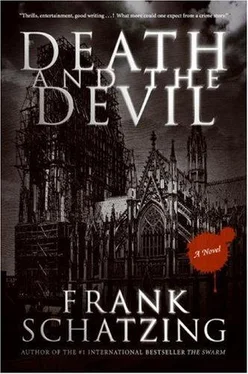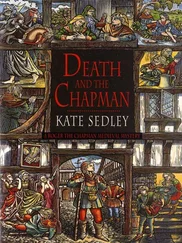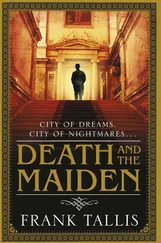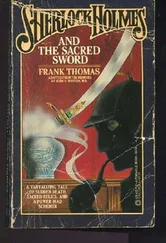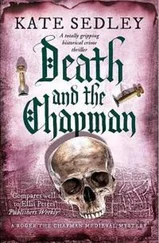“The truth? It’s simple. There was no archangel. The man imagined it. That solves our dilemma.”
Jacob stared at him, openmouthed. “A bloody clever conjuring trick.”
“Thank you.”
“Don’t mention it. Does that mean I dreamed it all, too?”
Jaspar shrugged his shoulders. “Who knows. You see how difficult it is to get at the truth. To see the truth, you must first doubt it. Put another way, in a desperate situation you have two alternatives. Headlong flight, as so far—”
“Or?”
“Or you use your head.” Jaspar stood up. “But do not forget,” he said, a severe expression on his face, “that I still have no proof that you’re really telling the truth.” Then a smile tugged at the corners of his mouth. “But I like you. At least I’m willing to try to find out. In the meantime you can stay here. Just think of yourself as my servant. And now you’d better get a few hours’ sleep. You look a little pale about the gills.”
Jacob let out a slow breath. “How did you mean that?”
“What?”
“That about using my head. What do you think I should do instead of running away?”
Jaspar spread his hands out. “Isn’t it obvious? Go on the attack.”
Matthias stood by the bier with Gerhard’s body, immersed in his memories.
He had gotten on well with the architect. Not that they had been quite what you would call friends. Matthias would not have sacrificed a friend. That would have been impossible anyway since, basically, he had no friends. But there was a characteristic he had shared with Gerhard, an exceptional clarity of mind combined with the ability to plan months and years ahead. Too few people saw time as something to be planned. The mystics even denied its very existence because an ever-rolling stream of time made possible what they condemned as heresy: progress, poison to the minds of the logicians with their Roscelin of Compiègne, Peter Abelard, Roger Bacon, Anselm, and the like. Most people saw time as a gift from God, to be consumed rather than exploited, parceled up into lauds and vespers, prime, terce, sext and none, matins and compline, rising, eating, working, eating, sleeping.
Time seen as the stage for human activity prompted the question of what a man could achieve in the course of his allotted span, if anything. The mystic’s concept of stasis was countered by the ideas of beginning and completion. But to complete something you had to live long enough, and did man ever live long enough to complete the things he began? A question that brought cries of “Heresy!” and “Criticizing God!” from traditionalists. It was the lot of man to suffer in silence, not to create. When the mystics talked of a crusade, they meant a crusade against the humanists as well. Christendom was more and more splitting up into enemy camps and Gerhard Morart, whose ambition had been to create something impossible to complete, had been pulled this way and that.
Matthias found the argument interesting, too. Did not he also, as he built up the Overstolz empire, place one stone upon another? It was not without reason that one of the mocking names for merchants was “sellers of time.” It also expressed an undercurrent of unease. They certainly never stood still.
The two men had often discussed the relationship between idea and execution, whether the concept of a new cathedral was incomplete without its physical realization and whether it was important to see your ideas carried through to completion. It was in this latter point that their views diverged. Matthias’s rational approach, which, as he well knew, came from a lack of imagination, led to a single-minded pursuit of immediate profit. Gerhard, on the other hand, saw reason simply as the best method of giving ideas that were clearly impracticable a basis of probability. In the final analysis, Gerhard had been a passionate visionary, inspired with the idea of creating something completely new, of introducing a revolutionary style into architecture that would fill the massive, earthbound buildings of his time, dominated by stone and shade, with pure light, soaring, slender, sublime—and above all, with no restriction on size. There was to be nothing castlelike about his vision of the heavenly city, the new Jerusalem, where God sat in state with His angels. Castles were the home of the Devil.
That was indeed something new. But however much they respected and admired him, some of his fellow citizens felt Gerhard’s enjoyment of the role of creator was all too plain to see. It was hardly surprising that the simple folk began to assume he had magic powers and rumors spread that he had called up Satan in the dead of night. There were many among the mendicant orders in particular who would have liked to see him tried for heresy and burned at the stake, together with Conrad von Hochstaden and Albertus Magnus. Had not Joachim of Fiore, whom the Franciscans held in high regard, prophesied the dawn of a new age for 1260, the age of a truly poor church? Was that colossal monument to human pride being built in Cologne an expression of that poverty? For many, Joachim’s prophecy represented the absolute truth, therefore the new cathedral, that most ambitious of enterprises, could only be the work of the Devil.
But then the pope and the emperor would have had to be burned along with Gerhard, since they supported the cathedral. It would be unwise, however, to criticize their decision publicly, if one wanted to avoid being beheaded, drowned, hung, drawn and quartered, or boiled in oil. The Holy Father had described the cathedral as a holy work and it was best to leave holy works be.
So the critics of the new cathedral in Cologne contented themselves with general sermons on dens of iniquity and vanity, which was nothing new, but not a risk, either. Soon Gerhard’s supposed pact had become merely part of the local folklore.
Gerhard’s real genius, however, lay less in conceiving a building such as the new cathedral, the perfect church, than in actually getting it built. His plans were not the product of visionary euphoria but of logical reasoning. Gerhard saw himself as a scientist pursuing goals that were absolutely unscientific. He marked out the space for the freest unfolding of the spirit with compass and measuring line; in his attempt to give it universal validity he submitted his divine inspiration to the unfeeling plumb line, transposed the exhilaration of heavenward soaring into a pinnacle of measurable height. And with every inch the cathedral grew, he became ever more painfully aware how small man was in the sight of God and how pitiful his attempt to rise above himself.
This contradictory nature of his work had brought Gerhard to the brink of despair. He might succeed in completing the impossible church, but not in imbuing it with meaning. Even as it rose up, it was a self-contradiction. It only worked in the mind; none of the goals that had instigated the idea of the building would ever be achieved.
Archbishop Conrad had laid not a foundation stone, but a gravestone to his hopes.
Despite all this, there had never been the slightest suggestion Gerhard was contemplating asking to be released from his contract. Deeply unhappy within himself, he had accepted the worldly nature of his commission, giving his passion for art and architecture free rein. There was no lack of money. The pope was happy to sign letters of indulgence, wealthy princes and clerics donated considerable sums in addition to offerings from the Church in Rome. In the meantime the archbishop’s petitores were abroad everywhere, tireless in their pursuit of contributions. Only a few years ago Conrad had asked Henry III of England to commend the collectors to his people; the proceeds had been unparalleled.
Gerhard built as if his life depended on it. And it did.
Читать дальше
